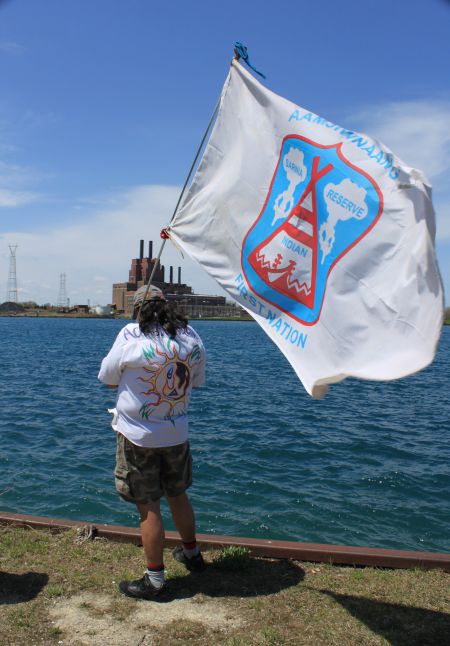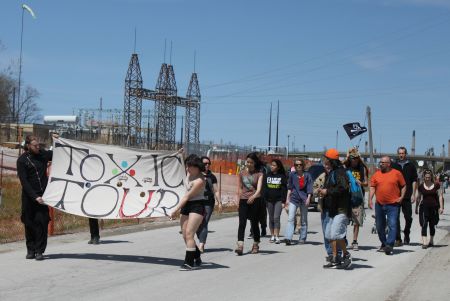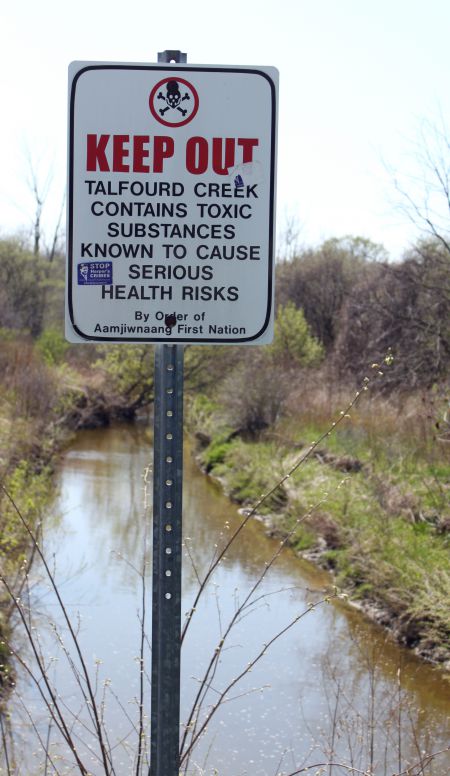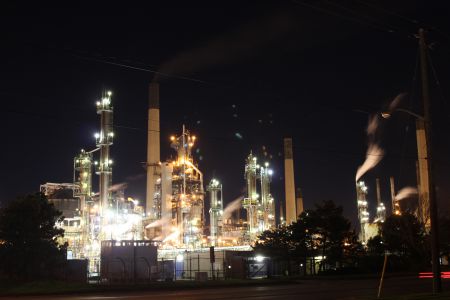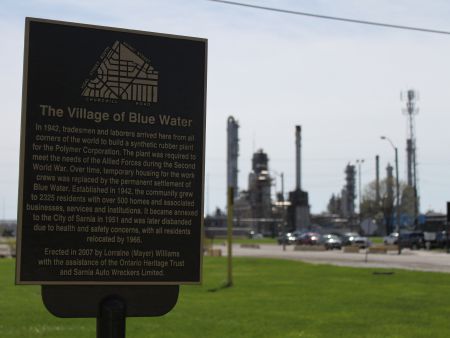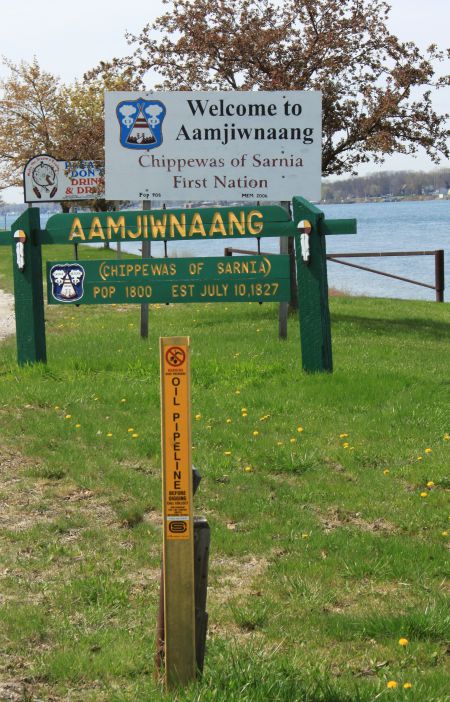The borders of Aamjiwnaang have been reduced over the years to where they are currently, just over 12 km2. A large portion cutting into the community's scenic waterfront area is now home to one of Suncor's refineries. Its numerous smoke stacks and flares tower over the surrounding trees. While standing on the road near the plant, the smell is formidable. So is the noise. Most of the industries in the area operate 24 hours a day, 7 days a week. There is no respite for your ears or nose and lungs. By the time the Toxic Tour got to the main entrance of Suncor, about an hour into our walk, my head was already pounding.
The community youth group, ASAP (Aamjiwnaang and Sarnia Against Pipelines), lead by Vanessa Gray, organized a disparate group of about 40 people on a tour to show what daily life on the reserve is like. The walk began at the Maawn Doosh Gumig Community and Youth Centre and worked its way to the St. Clair River, around a refinery and back to the centre. Participants held banners saying "Demand more from your Ministry of the Environment", "Cancer Alley" and two large snake puppets. The snakes, one blue and shiny, the other black and dripping represented the two combating forces of clean water and oil products being transported through the many existing and proposed pipelines.
Tar Sands crude
A small road branches off Vidal St., the main road along the river, and wraps around the side of Suncor's refinery. The facility was modified in 2008 to refine heavier crude oil that is shipped in from the tar sands. There among the stacks and enormous holding tanks is the graveyard currently in use by the Aamjiwnaang community. It is surrounded by Suncor on two sides, a highway on another and the site of Suncor's proposed ethanol plant on the fourth. There is very little room left for the community to continue keeping families and loved ones together. Norm, a member of the ASAP group, explained that although this is the graveyard currently in use, traditional burial sites were all along both sides of the St. Clair. Many were disrupted by the construction of industry and the large Blue Water Bridge which connects Ontario to Michigan. Lindsay Gray, shouting to be heard, explained that in addition to past graves being unearthed, the constant noise of the machines and regular sirens prohibit the gravesite from being a serene place for her ancestors. She asks the rhetorical question, "Whatever happened to rest in peace? Is this respectful?"
In 2004, the community succeeded in stopping Suncor's plans to build what would have been one of North America's largest ethanol refineries. The proposal was a tipping point and caused them to rally together to prevent another facility being built next-door to their houses. For days Aamjiwnaang members blockaded the road in protest. The pressure helped persuade Suncor to utilize an alternative site further to the south by Mooretown.
Air and Water Pollution
As the tour moved along, Zak, a resident of Sarnia and independent environmental monitor, pointed to an area along the road that crosses Talfourd Creek and leads back into Aamjiwnaang. It was recently discovered that an underground benzene pipeline had been slowly leaking. The cleanup is ongoing and orange plastic fences now block off the areas. Benzene is one of many aromatic hydrocarbons that have been leaked into the ground and air all too frequently. It is also considered a human carcinogen, being a cause of leukemia and other cancers. In 2009, Imperial Oil had an accident in which a "material containing benzene" was released causing a shelter-in-place order for residents in the extended perimeter of the plant. More recently, in 2013, a tanker ship unloading at the dock of Lanxess spilled four to five gallons of ethyl benzene into the St. Clair River.
But those are considered accidents. Regular, government approved, emissions from many of the factories contain a host of chemicals. The World Health Organization released a report in 2011 that charted air quality in urban settings around the world. Sarnia registered the most polluted air in Canada. Although the individual plant's emissions are bad but usually within the Ministry of Environment's parameters, the individual facilities do not operate in a vacuum. The pollution from the area's 60+ factories is combined; the cumulative effect is a problem that Aamjiwnaang community members are concerned about. So concerned that in 2011 they started a law suit.
Charter Challenge
Ada Lockridge and Ron Plain together with lawyers from Ecojustice, filed a suit against the Ontario Government claiming their Charter Rights are being violated, in particular their, "rights to life, liberty and security of the person, and the right to equality". Ecojustice explains the case by saying the community members "believe that Ontario must consider the cumulative impacts of pollution in Chemical Valley before approving more toxic emissions".
There has yet to be an exhaustive study of the impact air borne and water pollution has on the community. But some things have been well documented, such as the skewed birth ratio of two girls being born for every one boy. This anomaly is attributed to hormone disrupting chemicals such as PCBs, dioxins and pesticides, some of which are now banned but can remain in the environment for years.
Also, high levels of mercury have been found in the blood and urine of some Aamjiwnaang members and a community led survey reported asthma levels in adults and children far exceeding that of surrounding communities. Many of the health and environmental studies which show these results state that a link to the industry present all around Aamjiwnaang cannot be definitively made. It is an argument I can understand rationally but as I was standing with my headache, in the stink of Suncor, reading the warning sign posted at Talfourd Creek and hearing Vanessa say that when she was growing up, all the kids played in the creek, it was impossible for me not to make the connection between the industry and the negative health effects.
The charter challenge with Ecojustice is slowly making its way through the legal system. Suncor, one of the companies cited, has been tapping into their immense capital reserves to mobilize lawyers who are fighting the charge at every stage. It will be a long battle but in the mean time, members of Aamjiwnaang are living in what Lindsay sees as “chemical warfare”, an extension of Canada's genocidal policies toward First Nations.
North Sarnia
My hotel was north, along the St. Clair River, where the air does not stink and the cargo ships that glide along the horizon are like the industry to the south; a distant spectacle. I considered the history of the Blue Water community which was situated between Sarnia and Aamjiwnaang. It began in the 1940’s as housing for chemical plant workers and grew into a town of its own, reaching a peak population of over 2,000 people. But in 1966 the community was disbanded and all the residents relocated, largely to the north end of Sarnia, due to “health and safety concerns”.
It seems unjust to find a town full of factory employees too dangerous to live in, while the Native reserve just down the road is left to gasp for air and parents tell their children ‘don’t touch the water’. North Sarnia, with its lush golf course, yachts, and luxury cars reminds me that the petrochemical industry can be lucrative to some but toxic to many others.
(all photos by the author)
